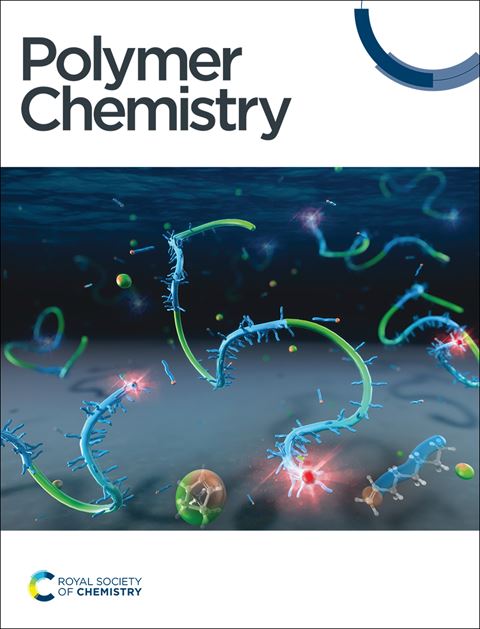Synthesis of poly(3,4-propylenedioxythiophene) (PProDOT) analogues via mechanochemical oxidative polymerization†
IF 4.1
2区 化学
Q2 POLYMER SCIENCE
引用次数: 0
Abstract
Conjugated polymers (CPs) are foundational materials in established and emerging organic electronic technologies, including organic photovoltaics, lithium-ion batteries, electrochromic displays and smart-windows, and thin-film transistors. Although CPs can be prepared via sustainable syntheses relative to their inorganic counterparts, current polymerization methods often invoke the use of toxic, hazardous solvents, such as toluene, chlorobenzene, or dimethylformamide, and high-temperatures (T > 100 °C) to afford polymer products in desirable yields and molecular weights (Mn). Here, we report the solvent-free synthesis of poly(3,4-propylenedioxythiophene) (PProDOT) analogues using mechanochemical oxidative polymerization without the application of external heating. PProDOT-OC6, which is functionalized with n-hexyloxy sidechains, is synthesized in 46% yield with a Mn of 16.9 kg mol−1 in 1 h using only a milling jar and ball, FeCl3 oxidant, and NaCl as an additive. The structural fidelity of mechanochemically synthesized PProDOT-OC6 is confirmed via1H-NMR relative to PProDOT-OC6 synthesized using solvent based oxidative polymerization, in addition to the optical absorption and electrochemical properties. The optimal mechanochemical polymerization conditions are then applied to PProDOT analogues with extended, n-decyloxy (PProDOT-OC10) or oligo(ethylene glycol) sidechains (PProDOT-OEG3) to demonstrate the tolerance of these solvent-free polymerization conditions towards structurally diverse sidechains. These findings offer a new platform and approach for further developing sustainable CP polymerization methods.

求助全文
约1分钟内获得全文
求助全文
来源期刊

Polymer Chemistry
POLYMER SCIENCE-
CiteScore
8.60
自引率
8.70%
发文量
535
审稿时长
1.7 months
期刊介绍:
Polymer Chemistry welcomes submissions in all areas of polymer science that have a strong focus on macromolecular chemistry. Manuscripts may cover a broad range of fields, yet no direct application focus is required.
 求助内容:
求助内容: 应助结果提醒方式:
应助结果提醒方式:


